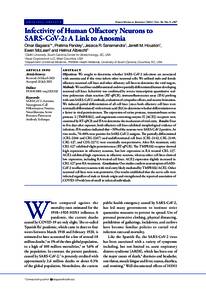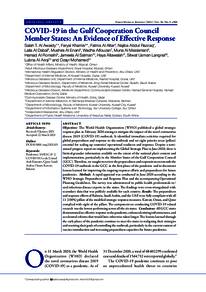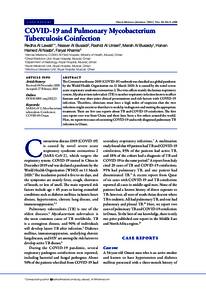Document
Infectivity of human olfactory neurons to SARS-CoV-2 : a link to anosmia.
Identifier
DOI 10.5001/omj.2021.128
Contributors
Pandey, Pratima., Author
Sanamandra, Jessica R., Author
Sanamandra, Jarrett M., Author
Houston, Jarrett M., Author
Publisher
Oman Medical Speciality Board.
Gregorian
2021-09
Language
English
Subject
English abstract
Objectives: We sought to determine whether SARS-CoV-2 infections are associated with anosmia and if this virus infects other neuronal cells. We utilized male and female olfactory neuronal cell lines and other olfactory cell lines to determine the viral targets. Methods: We used four undifferentiated and two partially differentiated human developing neuronal cell lines. Infectivity was confirmed by reverse transcription quantitative realtime polymerase chain reaction (RT-qPCR), immunofluorescence assay (IFA) probing with anti-SARS-CoV-2 antibody, evaluation of cytopathic effects, and neurite formation. We induced partial differentiation of all cell lines (since both olfactory cell lines were terminally differentiated) with retinoic acid (RA) to determine whether differentiation was a factor in viral permissiveness. The expression of serine protease, transmembrane serine protease 2 (TMPRSS2), and angiotensin-converting enzyme II (ACE2) receptors were examined by RT-qPCR and IFA to determine the mechanism of viral entry. Results: Four to five days after exposure, both olfactory cell lines exhibited morphological evidence of infection; IFA analyses indicated that ~30% of the neurons were SARS-CoV-2 positive. At two weeks, 70–80% were positive for SARS-CoV-2 antigens. The partially differentiated (CRL-2266 and CRL-2267) and undifferentiated cell lines (CRL-2142, CRL-2149, CRL-127, and CDL-2271) were essentially non-permissive. After RA treatment, only CRL-127 exhibited slight permissiveness (RT-qPCR). The TMPRSS2 receptor showed high expression in olfactory neurons, but low expression in RA treated CRL-127. ACE2 exhibited high expression in olfactory neurons, whereas other cell lines showed low expression, including RA-treated cell lines. ACE2 expression slightly increased in CRL-127 post RA-treatment. Conclusions: Our studies confirm neurotropism of SARSCoV-2 to olfactory neurons with viral entry likely mediated by TMPRSS2/ACE2. Other neuronal cell lines were non-permissive. Our results established that the nerve cells were infected regardless of male or female origin and strengthened the reported association of COVID-19 with loss of smell in infected individuals.
Member of
Resource URL
Citation
Bagasra, Omar, Pandey, Pratima, Sanamandra, Jessica R., Sanamandra, Jarrett M., Houston, Jarrett M., McLean, Ewen, & Albrecht, Helmut (2021).Infectivity of human olfactory neurons to SARS-CoV-2 : a link to anosmia. Oman Medical Journal, 36 (5), e307 [ 1-1
Category
Journal articles



